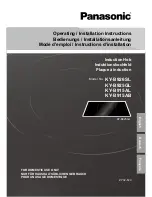
18
GWS 307, GKS 324, GKS 644, GKS 954
Using the appliance
Please note the safety instructions on page 17!
When operating the cooking zones, switch on the cooker hood/extractor
fan.
Igniting and adjusting the wok burner
The dual-circuit burner only has one knob for setting all of the functions. The
symbols for the individual control positions are arranged in a circle around the
control knob.
Control knob positions
1
Closed (OFF)
2
Ignition position
Outer and inner circuit - Full
flame
3
Outer circuit - Low flame
4
Inner circuit - Full flame
Outer circuit, closed
5
Inner circuit - Low flame
–
To ignite the burner, push in the control knob for the cooking zone and turn
it anti-clockwise to the "Ignition" (2) position.
The Wok burner is ignited automatically by the electric igniter.
–
Press the knob for approx. 10 seconds.
This is necessary as the gas taps of the appliance are secured thermo¦elec-
trically. It prevents unburned gas from permanently leaking if a burner goes
off.
If the burner has not ignited within 10 seconds, or if the flame has gone
out again, stop the ignition attempt. Wait at least a minute before you at-
tempt to ignite the burner again.
–
Should there be a power failure or should the spark plugs become damp,
escaping gas can also be ignited with a match or with a gas igniter.
–
After ignition turn the knob to set the flame as required. The change in the
size of the flame between position (4) and (5) is hardly visible. The stability
of the flame is limited for the lowest setting (position 5).
– Turning the knob anti-clockwise towards the “inner circuit low flame”
(5) mark will reduce the flame.
– Turning the knob clockwise towards the “ignition position” (2) mark will
make the flame higher.
No settings may be made between the „ignition position“ and “OFF”.
–
Parboil with a high flame and then turn the flame down.
Switching off the wok burner
–
To switch off turn the knob clockwise to „
z
“ (1).
Igniting and adjusting the wok burner
Each cooking zone has its own control button. Which control knob belongs to
which cooking zone can be seen from the symbols on the control panel.
Example: Knob for the back cooking zone:
The following three symbols are shown beside
the control knob for each cooking zone:
„
z
“
Off
High flame
Low flame
–
To ignite the respective burner, push in the control knob for the required
cooking zone and turn it to the "high flame" position.
The burner at the cooking zone is automatically ignited by the electric igni-
ter.
–
Press the knob for approx. 10 seconds.
This is necessary as the gas taps of the appliance are secured thermo¦elec-
trically. It prevents unburned gas from permanently leaking if a burner goes
off.
If the burner has not ignited within 10 seconds, or if the flame has gone
out again, stop the ignition attempt. Wait at least a minute before you at-
tempt to ignite the burner again.
–
Should there be a power failure or should the spark plugs become damp,
escaping gas can also be ignited with a match or with a gas igniter.
–
After ignition turn the knob to set the flame as required.
– Turning the knob anti-clockwise towards the “Low flame” mark will re-
duce the flame.
– Turning the knob clockwise towards the “High flame” mark will make
the flame higher.
No settings may be made between the „High flame“ and “OFF”.
–
Parboil with a high flame and then turn the flame down.
Switching off the cooking zone
–
To switch off turn the knob clockwise
to „
z
“.
Which are the best pots
and pans?
You can save time and power by choosing the best pans.
• Use pots and pans with a base
that is suitable for the size of
the cooking zone: The flames
should cover the base of pots
and pans but not burn beyond
the edge of the cookware ba-
se. Heat which flows out
around the sides cannot be used and will heat up the handles.
• Since gas flames ensure an optimal transmission of heat from the flame to
the base of pats and pans any type of cookware may be used provided it
is heat-resistant and suitable for use on flames.
Pots and pans made of stainless steel, aluminium, enamelling and cast iron
are ideal, but glassware is also suitable as long as the manufacturer of such
cookware expressely permits such use.
• Cookware with a very thin base or bases which are not quite flat is also
suitable; this means that you will not need to buy any new special cookwa-
re. Sandwich-based cookware is also very suitable; it does, however, not
have any advantage over standard cookware.
• Never use thin aluminium dishes or plastic vessels!
Pot diameter recommendations:
High speed burner: 22 to 26 cm.
Standard burner: 14 to 24 cm.
Economy burner: 8 to 16 cm.
Wok burner: 24 to 28 cm.
Notes on energy-saving cooking
• Only cook with very little liquid. The heating of the pot content takes less
time and you loose less vitamins and minerals by not pouring away the li-
quid.
• Always put a well closing lid on
the pot. The pot content only
boils over if the selected coo-
king level is too high. If the pot
content boils too much switch
to a lower cooking level. You
need less energy and avoid hu-
































